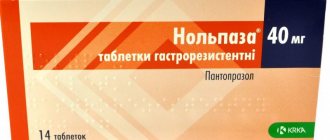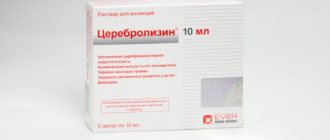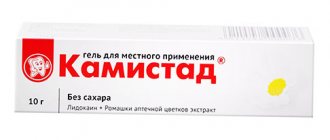Given the frantic pace of modern life, more and more people are struggling with problems of the musculoskeletal system. Stretching, inflammation, acute pain in the joints, lack of fullness of movement are the most common complaints of patients. The presence of such disorders significantly complicates a person’s normal life. Today, pharmaceutical companies can offer a huge number of medications that can reduce symptoms. Among many medications, Ketonal ointment has proven itself well.
This pain-relieving ointment is great for independent use, as it is very easy to use and has no serious contraindications or side effects.
Special instructions for the use of the drug Ketonal cream, gel
If a skin rash appears, topical use of the drug should be discontinued. The safety of using ketoprofen during pregnancy and lactation has not been established. Ketoprofen can be used in the first and second trimesters of pregnancy only if the expected therapeutic effect for the expectant mother exceeds the potential risk to the fetus. NSAIDs are not recommended for use during pregnancy beyond 36 weeks. When treating with Ketonal, you must stop breastfeeding. The drug does not affect the ability to drive vehicles or operate potentially dangerous machinery.
Ketonal
Ketonal (active ingredient - ketoprofen) is a non-steroidal anti-inflammatory drug (NSAID) from the Slovenian pharmaceutical industry, well known in Russia. The main, and perhaps the only area of its application is the symptomatic treatment of inflammatory processes (including various diseases of the musculoskeletal system) and the relief of pain of a wide variety of etiologies (for example, headaches and postoperative pain, myalgia, neuralgia, radiculitis).
Inflammatory processes are constant companions of a great variety of diseases. In this regard, the appearance of NSAIDs on the pharmacological “front stage” has become a real salvation. However, these drugs, unfortunately, are not free from a number of negative side effects due to the mechanism of action of NSAIDs, which is known to be associated with suppression of the activity of the enzyme cyclooxygenase (COX). This enzyme exists in two isoforms: COX-1 and COX-2. The effect of NSAIDs on COX-1 causes damage to the gastrointestinal mucosa of an erosive and ulcerative nature, as well as a number of other undesirable effects, including increased blood pressure and the development of peripheral edema. It was found that NSAIDs with a pronounced anti-inflammatory and analgesic effect cause a greater number of side effects. This is also true for NSAIDs with a long half-life. Ketonal has a short half-life of about 2 hours. At the same time, the drug is endowed with a pronounced analgesic effect, sufficient for its use in surgical, gynecological and oncological practice.
As comparative clinical trials have shown, the analgesic effect of ketonal is stronger than that of such “colosses” of the NSAID group as diclofenac, indomethacin and ibuprofen. In addition, ketonal “works” in more than 90% of patients, which should be recognized as a rather impressive figure, especially compared to other NSAIDs, for which the percentage of patients responding to the drug is about 70-80%.
Ketonal is available in several dosage forms: tablets, capsules, cream, gel, injection solution and suppositories. Such a wide range of release forms gives doctors a large space for therapeutic “maneuver”, allowing them to select the method of administration in accordance with the nature of the disease, its severity and the individual characteristics of the patient. As already mentioned, ketonal, like other NSAIDs, can cause gastrointestinal disorders. To prevent them, you can take tablets or capsules not with water, but with milk, or accompany the intake of ketonal with drugs that reduce stomach acidity - antacids (neither milk nor antacids affect the degree of absorption of the drug in the gastrointestinal tract). Long-term use of ketonal requires the patient and his doctor to carefully monitor liver and kidney functions, as well as regularly monitor blood counts. Another important point to keep in mind when prescribing ketonal: it, like other NSAIDs, can mask the symptoms of infectious diseases, so the use of drugs in this group should be done after consultation with a doctor.
Contraindications and side effects
Despite the fact that there are few contraindications to the use of Ketonal ointment, they are still present and you need to know about them. Like many other medications, the cream is not prescribed to patients who are highly sensitive to the substances that make up the medication. Allergy sufferers who react to salicylates, tiafprofenic acid and other non-steroidal components are also contraindicated in using the cream. It is especially dangerous to be treated with Ketonal for patients suffering from asthma attacks while using such drugs.
Reviews
“I had to face a problem such as inflammation of the knee, I spent a long time selecting a medicine, a friend recommended Ketonal ointment. After the first use I felt significant relief. An excellent medicine at an affordable price, now I always use it and recommend it to others.” Marina, 42 years old.
“I have problems with my back; due to the fact that my work involves lifting weights, my lower back often gets inflamed. I tried a lot of medicinal ointments and gels, from budget ones to the most expensive and popular drugs. Once I bought Ketonal cream, and my surprise knew no bounds: after a few days the pain subsided and I felt relief. Now I always have this medical product in my first aid kit, just in case.” Marina, 30 years old.
“When I was young, I played sports, I had injuries, and now I often feel pain in my joints. I consulted with specialists, did examinations and, basically, was treated with medication. Recently I turned to another doctor, who advised me to buy an inexpensive analgesic - Ketonal. After the first course of therapy, I began to lead an active lifestyle again and am not afraid of the recurrence of old injuries. I refused injections and use only my favorite and very effective ointment.” Veronica, 38 years old.
“They have been using only this cream for many years, I would like to note that it copes much better with joint pain than its analogues. I advise everyone, the effect is noticeable after the first application.” Vitaly, 52 years old.
Instructions for use
To avoid unpleasant consequences, before purchasing the cream, you must consult a doctor and undergo special tests to exclude contraindications. It is worth noting that only a medical professional can prescribe an anti-inflammatory drug. The instructions for use included in the box contain only general recommendations for the use of Ketonal ointment.
Before applying the ointment, it is necessary to clean the skin area of impurities and dry thoroughly. Squeeze out a small amount of the drug from the tube, about 3-4 centimeters, and apply with massaging movements to the skin located above the inflamed joint. It is not recommended to rub the cream in too intensively; movements should be massaging and not sharp. The procedure continues until the drug is completely absorbed, after which it is forbidden to cover the skin with an occlusive dressing.
The cream should not be used in the area of the eyelids and skin around the eyes, and it is also necessary to prevent Ketonal from coming into contact with the mucous membranes of organs. It is not recommended to use the product when applying it to places where the skin is damaged by wounds, cracks, inflammation, rashes, etc.
Important! After completion and during treatment using Ketonal ointment, doctors advise not to stay in the sun for a long time for 14 days.
To avoid side effects, it is necessary to strictly adhere to the dosage of the medication. Based on the information in the instructions for use, in order to avoid an overdose of ketoprofen, it is allowed to apply a strip of cream per day not exceeding 50 mm in length. This dosage can be divided into two applications or limited to one application.
Ketonal's analogs
Naturally, like many other medications, Ketonal ointment has analogues, some of them are cheaper, some are more expensive. It happens that the search for a drug substitute is also based on contraindications.
The drug Fastum Gel, popular among many patients, has the same pharmacological effect. Many people use Vipratox or Voltaren Emulgel. Experts may also recommend purchasing:
- Maclura;
- Artrum gel;
- Artron triactive;
- Remisid;
- Nimid gel.
The long list of Ketonal analogues does not end there, however, only the attending physician can determine what is best for the patient and prescribe the most effective drug that suits the patient’s clinical picture.
Indications for use
Ketonal ointment is trusted by many medical professionals. So, in what cases should this remedy be used? What is noteworthy is that the effect of the cream covers many symptoms - it copes remarkably with joint pain and helps relieve inflammation during exacerbation of diseases of the musculoskeletal system. Ketonal is often used by patients suffering from rheumatoid arthritis, osteoporosis, radiculitis and various neuralgia. Doctors often advise using the ointment for periarthritis, Reiter's syndrome, and for patients with myalgia and tendonitis.
Ketonal
Undesirable drug combinations
The combined use of ketoprofen with other NSAIDs (including selective cyclooxygenase-2 inhibitors), salicylates in high doses is not recommended, due to the increased risk of gastrointestinal bleeding and ulceration of the gastrointestinal mucosa.
Simultaneous use with anticoagulants (heparin, warfarin), antiplatelet agents (ticlopidine, clopidogrel) increases the risk of bleeding. If the use of such a combination is unavoidable, the patient's condition should be carefully monitored.
When used simultaneously with lithium preparations, it is possible to increase the concentration of lithium in the blood plasma up to toxic values. The concentration of lithium in the blood plasma should be carefully monitored and the dose of lithium preparations should be promptly adjusted during and after treatment with NSAIDs.
Increases the hematological toxicity of methotrexate, especially when used in high doses (more than 15 mg per week). The time interval between stopping or starting therapy with ketoprofen and taking methotrexate should be at least 12 hours.
Combinations to use with caution
During therapy with ketoprofen, patients taking diuretics, especially if dehydration develops, have a higher risk of developing renal failure due to a decrease in renal blood flow caused by inhibition of prostaglandin synthesis. Before starting to use ketoprofen in such patients, rehydration measures should be carried out. After starting treatment, it is necessary to monitor kidney function.
Combined use of the drug with ACE inhibitors and angiotensin II receptor blockers in patients with impaired renal function (with dehydration, elderly patients) can lead to worsening deterioration of renal function, including the development of acute renal failure.
During the first weeks of simultaneous use of ketoprofen and methotrexate at a dose not exceeding 15 mg/week, blood tests should be monitored weekly. In elderly patients or if there are any signs of renal impairment, the study should be performed more frequently. Combinations to take into account
Ketoprofen may weaken the effect of antihypertensive drugs (beta blockers, angiotensin-converting enzyme inhibitors, diuretics).
Concomitant use with selective serotonin reuptake inhibitors (SSRIs) increases the risk of gastrointestinal bleeding.
Concomitant use with thrombolytics increases the risk of bleeding.
Concomitant use with potassium salts, potassium-sparing diuretics, ACE inhibitors, angiotensin II receptor blockers, NSAIDs, low molecular weight heparins, cyclosporine, tacrolimus and trimethoprim increases the risk of developing hyperkalemia.
When used simultaneously with cyclosporine and tacrolimus, there may be a risk of additive nephrotoxicity, especially in elderly patients.
The use of several antiplatelet drugs (tirofiban, eptifibarid, abciximab, iloprost) increases the risk of bleeding.
Increases the plasma concentration of cardiac glycosides, slow calcium channel blockers, cyclosporine, methotrexate and digoxin.
Ketoprofen may enhance the effect of oral hypoglycemic and some anticonvulsants (phenytoin).
Concomitant use with probenecid significantly reduces the plasma clearance of ketoprofen.
Nonsteroidal anti-inflammatory drugs may reduce the effectiveness of mifepristone. Taking NSAIDs should be started no earlier than 8-12 days after stopping mifepristone.
Pharmaceutically incompatible with tramadol solution due to precipitation.
Release form and composition
The medical product Ketonal ointment resembles a thick white cream and is odorless. Some manufacturers use the term cream in the name, others use ointment. But you can be absolutely sure that this is the same drug. The medicine is available in a small aluminum tube in two volumes - 50 and 30 g.
The main and main active element of the drug is the substance ketoprofen. Its content in one gram of ointment is about 50 mg. In addition, Ketonal contains additional substances, for example, isopropyl myristate, white petrolatum, propylene glycol, glycerin oleate, magnesium sulfate, water and others.








